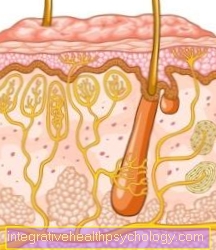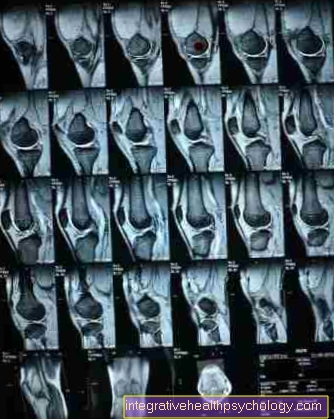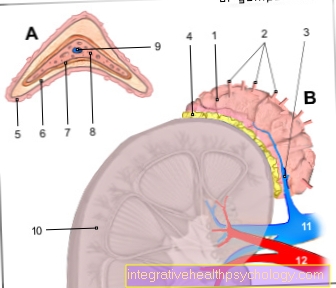Lipase
What is the lipase?
The term lipase stands for a group of enzymes that break down special dietary fats, so-called triacylglycerides, into their components.
They therefore play a crucial role in digestion.
In the human body, the lipase occurs in several sub-forms that are formed in different places but have the same effect. They can occur both inside the cells and outside the cells. In general, however, the term lipase refers to the form of the enzyme that is produced by the cells of the pancreas (also known as the pancreas).
This enzyme is therefore also called pancreatic lipase.

Task and function
The pancreatic lipase is formed in special cells of the pancreas, which release the enzyme together with the remaining digestive secretions of the pancreas through a duct system into the small intestine.
This is where the enzyme unfolds its effect:
The job of pancreatic lipase is to break down special dietary fats into their components, which is what makes digestion possible.
Since only one other enzyme can break down these dietary fats in addition to pancreatic lipase, the production of the enzyme is essential for digestion in the small intestine.
At the end of the duodenum, the pancreatic lipase has already broken down a large part of the fats.
The dietary fats that are broken down by lipase are called triacylglycerides (TAGs).
These consist of three fatty acid chains that are linked by glycerine.
Due to the size of these triacylglycerides, they cannot simply pass through the mucous membrane in the intestine and be absorbed.
The function of the pancreatic lipase is essential for this.
By breaking the ester bond between the fatty acid chains and the glycerine, the size of the individual products is significantly reduced.
Since all products are also electrically neutrally charged, they can then pass through the intestinal mucosa much more easily.
In the intestinal mucosa, the individual fatty acids are again combined with glycerine to form a triacylglyceride.
They are also built into special transport proteins that enable them to get into the bloodstream.
For the full function of the pancreatic lipase in the small intestine, some requirements must still be met.
As a digestive enzyme, lipase is not released into the duct system in the pancreas in its active form. Activation only takes place in the small intestine.
This is done by the digestive enzymes chymotrypsin and trypsin.
In addition to a basic pH value and calcium, a coenzyme must also be present. This coenzyme is called colipase.
Colipase is also released as an inactive precursor and converted into active form by the enzyme trypsin.
In addition to the cleavage of triacylglycerides, pancreatic lipase also has the function of cleaving retinyl esters.
After the breakdown, the resulting retinol can be absorbed into the body.
As vitamin A, retinol assumes a number of important functions in the body, for example in the process of vision.
Other forms of the group of lipases occur in the human body, for example in adipose tissue.
Here, too, triacylglycerides are broken down into their components. Although this is not for digestion, it is nevertheless important for other important processes such as providing energy reserves during long breaks between meals or during endurance sports.
Where is the lipase formed?
The pancreatic lipase is formed in the so-called exocrine part of the pancreas.
This exocrine part consists of special cells, the acinar cells, which release digestive secretions into the small intestine via an excretory duct system.
These cells are found in the entire pancreas and must be separated from the endocrine part.
In contrast to the exocrine part, the endocrine part forms hormones such as insulin. In addition to lipase, the acinar cells also produce digestive enzymes.
What is lipase and how is it measured?
The term lipase value refers to the concentration of enzyme that is detected in a substance by the laboratory.
For this, blood is usually taken from the affected person by venipuncture.
The laboratory now uses this to determine the enzyme concentration.
Due to the high stability of the pancreatic lipase in the blood serum, a reliable value can be determined even after a week.
In rare cases, the lipase concentration can also be determined from the intestinal contents. A stool sample is usually taken for this.
The upper limit for lipase in the blood serum is usually around 65 U / l (units / liter).
In healthy people, the concentration should not be lower than 30 U / l.
Different limit values apply to children.
With them, the concentration of pancreatic lipase in the blood serum should be between 30 U / l and 40 U / l.
Since this value is strongly dependent on the laboratory method, this value can be subject to large fluctuations. The limit value is also specified differently by each laboratory, which is why, in case of doubt, the limit values specified by the laboratory should be relied on.
Read more detailed information on this in our article:
- Lipase level
What reasons can there be if the lipase is increased?
Elevated levels of pancreatic lipase can occur in the context of many diseases.
However, since some are less common, these diseases are initially given less attention when the values are higher. As a rule, there is an increase in the concentration of lipase in the blood serum due to a reduced outflow of lipase into the blood.
Typical diseases in which the limit value is exceeded are acute or chronic pancreatitis (acute or chronic pancreatitis). The measured value can rise to over 75 times the normal value within hours and be increased over several days.
Together with the value of the amylase in the blood serum, this laboratory value reaches a very high specificity. However, the level of the increase does not allow any statement to be made about the course of the disease.
Do you suspect that you might have pancreatitis? You can recognize the clinical picture by these symptoms:
- Symptoms of inflammation of the pancreas
In the following diseases, there is also an increase in the lipase value, which is, however, much less pronounced. The causes for this include, for example, an ulcer of the stomach (ulcus ventriculi) or an ulcer of the duodenum (ulcus duodeni). Furthermore, diseases of the biliary tract can cause this. This would be, for example, an occlusion of the bile duct with a gallstone. Inflammation of the gallbladder can also be the cause. Typhoid fever caused by bacteria should also be considered as a cause. The viral cause can be mumps (goat peter). An intestinal obstruction can also lead to a reduced outflow of digestive secretions from the pancreas and thus increase the lipase level in the blood serum.
This article might also interest you:
- Lipase increased
At what pH value does the lipase work optimally?
The pancreatic lipase has its optimum effect in the alkaline range.
This is approximately at a pH value between 7 and 8.
At a pH that is above or below the activity of the pancreatic lipase decreases rapidly.
After the food pulp from the stomach reaches the small intestine, this pH value must be reached quickly.
Due to the stomach acid, the pH value is around 1 to 3 up to this point.
The alkaline pH value is achieved through the secretion of alkaline secretions. There are special glands for this at the beginning of the small intestine.
In addition, the pH of the digestive secretions of the pancreas is in the alkaline range.
In addition to numerous enzymes, bicarbonate is also released by the pancreas.
What is the consequence in the intestine if there is too little lipase?
If there is too little lipase in the gut, it leads to a range of symptoms.
However, these only occur when only about 10% of the original amount of pancreatic lipase is released into the intestine. Symptoms also occur that are not primarily due to the lack of lipase.
Since a lipase deficiency does not occur in isolation, the intestine lacks the other digestive enzymes of the digestive secretion as well as the alkaline bicarbonate.
As a result, stomach acid is poorly neutralized and ulcers of the small intestine are more common.
Due to the lack of lipase, the poor digestion of fats leads to a digestive disorder of these fats.
In addition, proteins and carbohydrates are also absorbed into the body in reduced quantities via the intestinal mucosa.
All of this in turn leads to various symptoms:
- On the one hand, a decrease in weight is observed due to the reduced absorption into the body.
- It also leads to vitamin deficiency symptoms.
The fat-soluble vitamins A, D, E and K. are affected.
- On the other hand, vomiting, nausea and diarrhea (fatty stools) are observed.
- Since more undigested food gets into the intestine as part of the reduced digestion, bacteria can settle here, which cause flatulence through gas formation.
How is lipase affected by alcohol?
Alcohol is a substance that can have a profound effect on the level of pancreatic lipase in blood serum.
Massive use over a long period of time leads to an increase in lipase levels.
This is due to the fact that alcohol consumption over a long period of time can lead to inflammation of the pancreas.
This can be either acute or chronic.
In both cases, the lipase value increases sharply and can reach 75 times the normal value.
If this occurs, a doctor should be consulted and alcohol consumption should be stopped completely.
What does a lipase inhibitor do?
Lipase inhibitors such as orlistat are used to inhibit the activity of lipase in the small intestine.
The inhibitors bind the enzyme and do not release it.
This leads to less decomposition of dietary fats (especially so-called triacylglycerides), which means that they are less absorbed.
In doing so, it is not specifically one type of dietary fat that is reduced, but the total amount is reduced.
The primary goal of lipase inhibitors is to prevent the absorption of fats.
In this way, therapeutic attempts are made to reduce weight by making the body less fat available as a source of energy.
Lipase inhibitors are therefore used in the therapy of obesity, but also type II diabetes mellitus and the prophylaxis of various cardiovascular diseases that are significantly influenced by obesity.
However, since the use of lipase inhibitors, as with a deficiency in lipase, more fats are not absorbed in the intestine, typical side effects such as diarrhea (fatty stools), vomiting and nausea can occur.
How does pancreatitis affect lipase production?
Pancreatitis is a typical disease in which the lipase limit is exceeded.
This means that lipase production increases massively.
It does not matter whether you have acute or chronic pancreatitis (acute or chronic pancreatitis). The measured value can rise to over 75 times the normal value within hours and be increased over several days.
However, the level of the increase does not allow any statement to be made about the course of the disease.
Do you suspect or know you have pancreatitis? Also read the article:
- Duration of therapy for pancreatitis
How can you substitute the lipase?
A substitution of the pancreatic lipase is usually necessary in the case of exocrine pancreatic insufficiency.
This means that the cells that make up the digestive secretions can produce a maximum of 10% of the original amount.
This insufficiency occurs mostly as a result of chronic alcohol abuse.
The enzyme is supplied to the body through ingestion of film-coated tablets. The tablets contain the active ingredient pancreatin. The active ingredient comes from the pancreas of pigs.
So that the tablets can develop their effect in the small intestine, they must be specially protected for passage through the stomach. They contain a protective layer that counteracts the breakdown of the active ingredient by the gastric juice.
The active ingredient is only released in the small intestine.
The amount that needs to be taken into the body depends on the degree of insufficiency of the pancreas, the fat content of the food and the body weight.
In addition, the tablets should be taken immediately before or during the meal.
How does lipase work with amylase?
Lipase and amylase are both digestive enzymes that are made in the pancreas.
If necessary, they are both released into the duodenum through an excretory duct system.
While pancreatic lipase is responsible for digesting special dietary fats, (pancreatic) amylase is responsible for digesting carbohydrates.
They break down long-chain carbohydrates into short-chain carbohydrates or individual sugar molecules.
The two digestive enzymes work together in the small intestine to complement each other.
Both enzymes can react very well with their respective substrates. However, their function is very substrate-specific, which is why the lipase can neither break down carbohydrates nor the amylase fats.
In the event of a deficiency in an enzyme, either carbohydrates or fats would not be digested properly and the affected person would have very poor digestion.
What is the base of the tongue lipase?
The term tongue base lipase describes an enzyme that, like all lipases, can break down special dietary fats (TAGs) into its components.
In contrast to the pancreatic lipase, the tongue base lipase is not produced in the pancreas.
The enzyme is produced in the oral cavity and means that the first step in the digestion of fats takes place here.
In babies, a high level of tongue base lipase can be detected in the saliva. In contrast, little or no tongue base lipase can be detected in adults.
Recommendations from the editorial team:
- Increased lipase level
- Task of enzymes in the body
- The lipase level
- Functions of the pancreas
- Underactive pancreas - how bad is it?




























